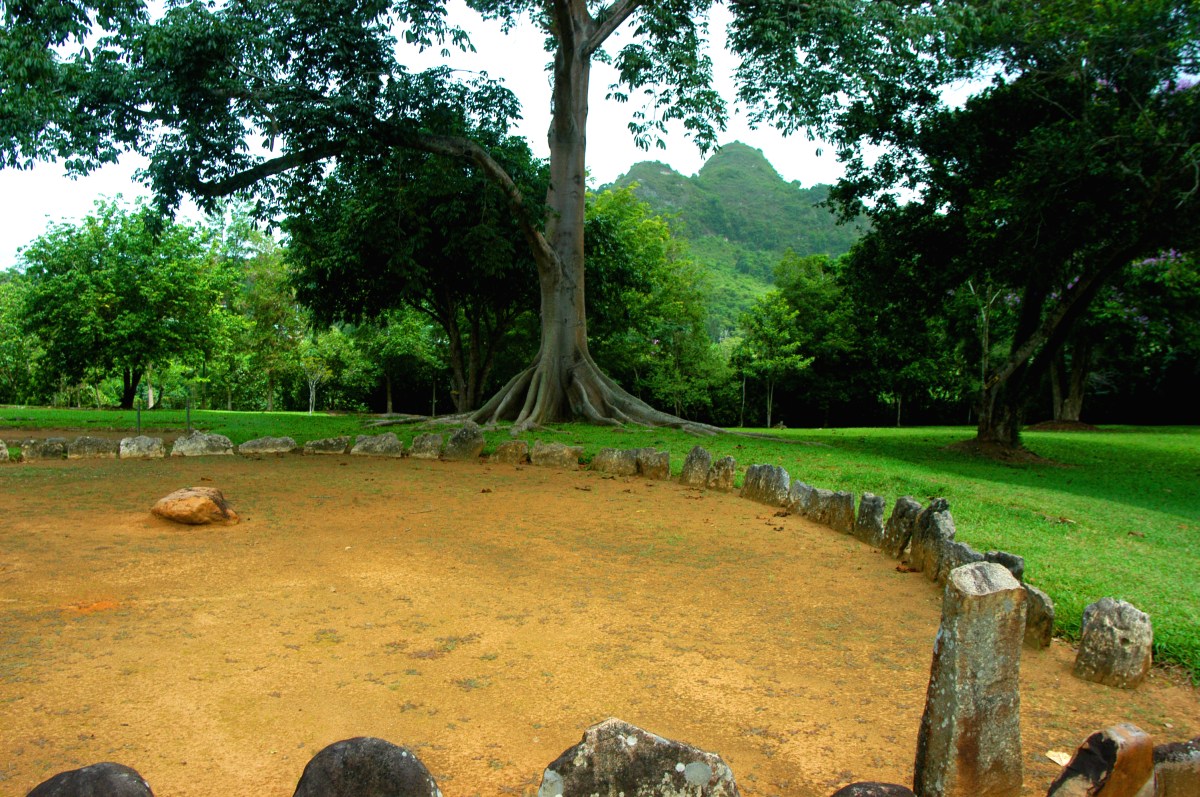The Batey
The Batey was a sacred space for celebrations and meetings where Taíno Indians interacted socially through the ball game. These Bateyes, also called Plazas by archeologists, used to be constructed by Indians in different forms and shapes. Bateyes were commonly rectangles of different lengths and widths, and some shapes were squares and circles. It seems that the characteristics of the Bateyes were defined by the different constellations and seasons of the so-called “year.”
If you visit the Caguana Indigenous Ceremonial Park (in Utuado) on specific dates like solstices and equinoxes, it’s easy to find the sun dancing by some of the Bateyes during the same hours (especially at noon) every year. Other characteristics are that all of these Plazas are delimited by different rocks of different shapes, sizes, and types — mainly volcanic rocks, limestone, and metamorphic rocks. Batey Zipline Adventure invites you to celebrate with nature the enjoyment of that sacred space where you will learn and have fun with us in a responsible and safe way.

The Taíno Indians: Native Americans of the Caribbean

Who are the Taínos? The US Government says they are extinct, but they are not. Most likely you might know them as Latinos, a Spanish-speaking person of Latin American (the Spanish-speaking part of the Americas, south of the US) descent. Many, but not all, modern-day Taínos are unaware of their lineage. To understand how that could happen you must know the story from the beginning.
Approximately 1,500 years ago, the Arawak people of South America began migrating northward along the many scattered islands located between South and North America, an area we now refer to as the Caribbean. For a thousand years, their population grew and the people lived in harmony. The people covered all the islands of the Caribbean, the major ones as they are now known — Cuba, Puerto Rico, and Hispaniola — as well as all the smaller ones — the Bahamas, Bimini, Jamaica, etc. Certain groups of island people identified themselves as Lokono, Lucayan, Carib, Ciboney, Arawak, but most islands were primarily inhabited by people who called themselves Taíno, which stood for “the good people” in their language. The different groups intermarried extensively to strengthen ties amongst themselves.
Their culture was beautiful. They were aware of a divine presence whom they called Yocahu; worshipping and giving thanks were major parts of their lives. They had a social order that provided the leaders and guidelines by which they all lived. They hunted, fished, cultivated crops, and ate the abundant fruits provided by nature. They were clever and ingenious and had everything they needed to survive. They had beautiful ceremonies that were held at various times — birth, death, marriage, harvest, naming, and coming of age, to name a few. They had a special reverence for the Earth Mother (Atabey) and had respect for all living things knowing that all living things are connected. There was little need for clothing due to the tropic heat, but upon reaching puberty, both males and females would wear a small woven loincloth. Puberty was also the time at which they were considered old enough to be married. The population estimates for the Taíno people at the height of their culture in 1492 are as high as 8,000,000!
The Taíno Indians: Native Americans of the Caribbean
Who are the Taínos? The US Government says they are extinct, but they are not. Most likely you might know them as Latinos, a Spanish-speaking person of Latin American (the Spanish-speaking part of the Americas, south of the US) descent. Many, but not all, modern-day Taínos are unaware of their lineage. To understand how that could happen you must know the story from the beginning.
Approximately 1,500 years ago, the Arawak people of South America began migrating northward along the many scattered islands located between South and North America, an area we now refer to as the Caribbean. For a thousand years, their population grew and the people lived in harmony. The people covered all the islands of the Caribbean, the major ones as they are now known — Cuba, Puerto Rico, and Hispaniola — as well as all the smaller ones — the Bahamas, Bimini, Jamaica, etc. Certain groups of island people identified themselves as Lokono, Lucayan, Carib, Ciboney, Arawak, but most islands were primarily inhabited by people who called themselves Taíno, which stood for “the good people” in their language. The different groups intermarried extensively to strengthen ties amongst themselves.
Their culture was beautiful. They were aware of a divine presence whom they called Yocahu; worshipping and giving thanks were major parts of their lives. They had a social order that provided the leaders and guidelines by which they all lived. They hunted, fished, cultivated crops, and ate the abundant fruits provided by nature. They were clever and ingenious and had everything they needed to survive. They had beautiful ceremonies that were held at various times — birth, death, marriage, harvest, naming, and coming of age, to name a few. They had a special reverence for the Earth Mother (Atabey) and had respect for all living things knowing that all living things are connected. There was little need for clothing due to the tropic heat, but upon reaching puberty, both males and females would wear a small woven loincloth. Puberty was also the time at which they were considered old enough to be married. The population estimates for the Taíno people at the height of their culture in 1492 are as high as 8,000,000!

